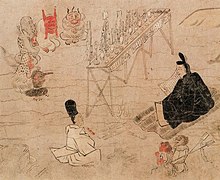Shikigami
Shikigami ( Japanese 式 神 / 識 神 ), also read as Shikijin and Shiki no kami , is the name for a fictional being from Japanese mythology . It is counted to the group of Kami ( 神 ) and is a spirit . The Inugami are very similar to them .
description
The belief in Shikigami arises from the Onmyōdō cult. According to this must be a shikigami by a complex and elaborate ceremony conjured be. Usually they are supposed to be invisible, but they can also take shape and change it at will or according to the will of their summoner. Usually they then appear as small animals or birds. In order to give shape to invisible Shikigami and to be able to control them, they are often captured in folded and / or artistically cut paper figures. The power of a shikigami depends on the spiritual powers and knowledge of his master.
However, Shikigami can also be dangerous for the summoner, as they develop a life of their own, gradually evade the control of their master and then usually attack and kill him.
function
Shikigami are used to carry out dangerous or risky jobs, such as espionage , theft and / or enemy tracking. If a Shikigami summoner is particularly skilled in his arts, his Shiki can take possession of animals and even humans and then control them.
Shikigami in the modern subculture
In modern anime series and fantasy novels, such as Inuyasha , Nura - Lord of the Yōkai and Spirited Away , Shikigami are common. In "Inuyasha" they are often portrayed as traditional paper figures, for example as little men scurrying around and providing distraction in combat, as magical replicas of Inuyasha and Kagome attack their role models, or as imitations of demons repeatedly mislead Inuyasha. In “Spirited Away” the Shikigami appear as paper birds that attack Spirited Away's friend Haku. In "Nura - Lord of the Yōkai" Shikigami are used in the fight against demons.
literature
- G. Rodney Avant: A Mythological Reference . AuthorHouse, Bloomington 2005, ISBN 1-418-49278-7 , page 356.
- Patrick Drazen: A Gathering of Spirits: Japan's Ghost Story Tradition: from Folklore and Kabuki to Anime and Manga . iUniverse, New York 2011, ISBN 1-462-02942-6 , page 224.
- Norman Havens, Nobutaka Inoue: An Encyclopedia of Shintō (Shintō Jiten): Kami (= Volume 1 of: An Encyclopedia of Shintō .). Institute for Japanese Culture and Classics Kokugakuin University, Tokyo 2006, ISBN 4-905-85308-7 , pages 84-90.
- Kazuhisa Fujie, Martin Foster: The Inu-yasha Experience: Fiction, Fantasy And Facts (= Volume 5 of: Mysteries and Secrets Revealed!. ) DH Publishing, Tokyo 2004, ISBN 1-932-89708-9 , page 119.
- Hiroshi Shiibashi: Nura: Rise of the Yokai Clan . VIZ Media LLC, San Francisco 2011, ISBN 142153892X .
Web links
- Satoshi Itō: "Shikigami" . In: Encyclopedia of Shinto. Kokugaku-in , March 13, 2005 (English)
